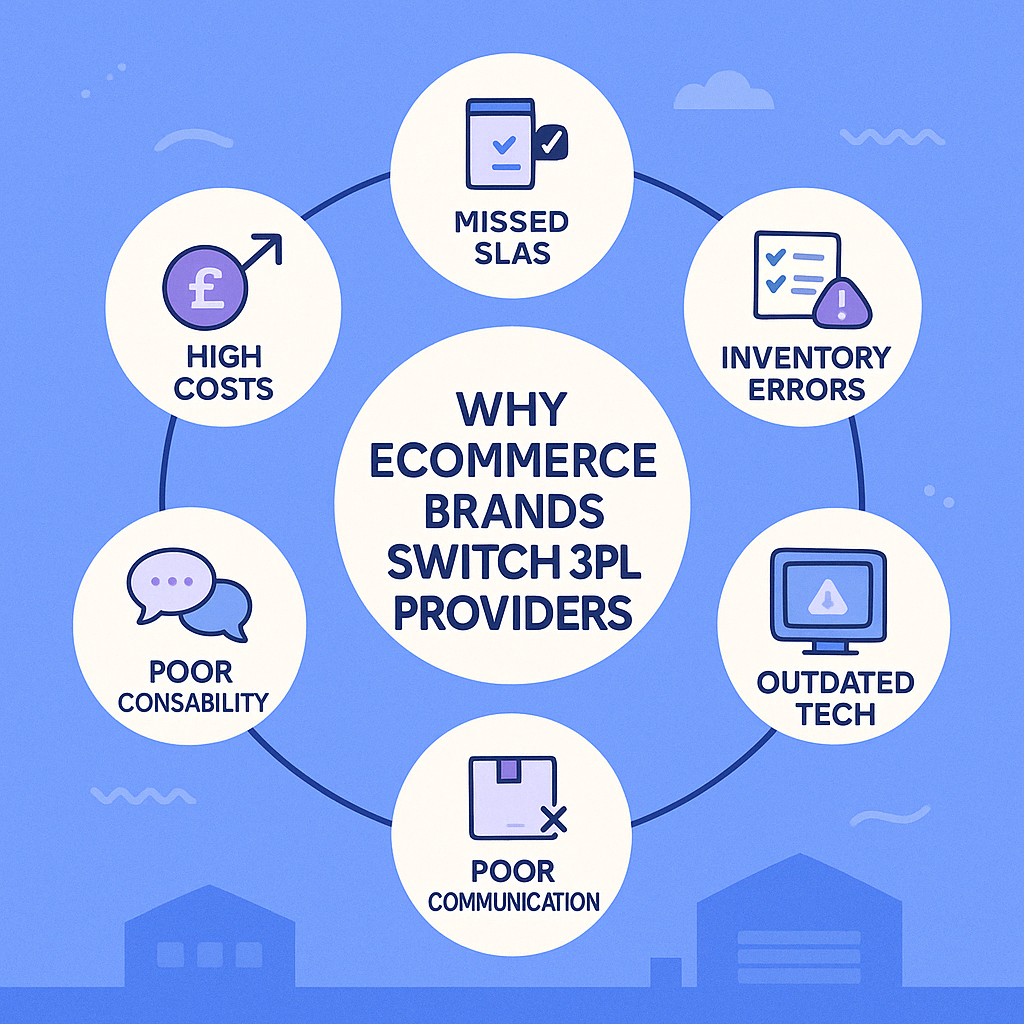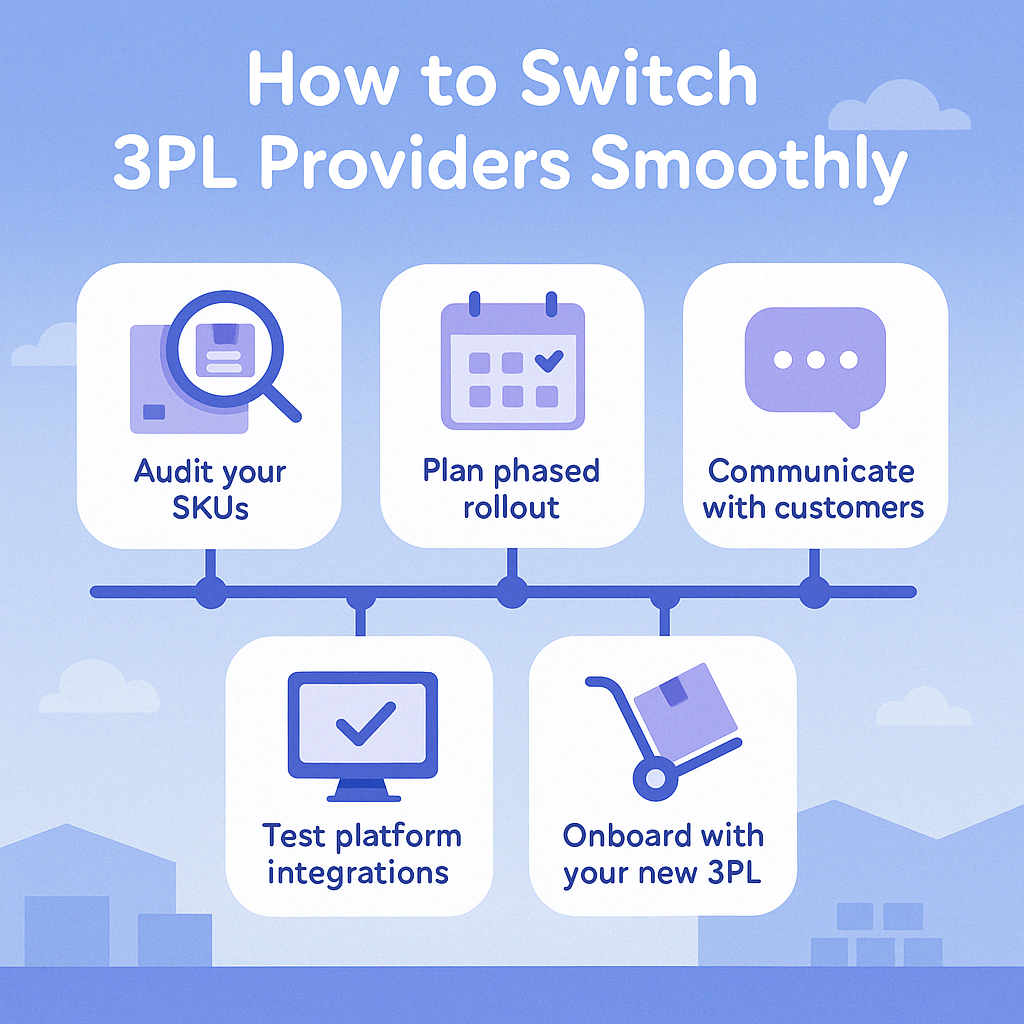Changing 3PL providers is a big decision for most eCommerce brands. Logistics is the engine room of online retail, and switching fulfilment partners can feel risky, especially if you’re trying to avoid delays, customer complaints, or stock issues. But staying with the wrong provider often causes more problems in the long run.
As your business grows, what once worked may no longer be suitable. If your fulfilment partner can’t keep up with your order volume, technology needs, or delivery expectations, it’s time to reassess.
What Does Changing 3PL Providers Involve?
Third-party logistics (3PL) providers are responsible for order fulfilment, warehousing, inventory management, packing, and shipping. Many also offer platform integrations, customer returns processing, and real-time tracking features.
Changing 3PLs typically means transferring your stock, integrating new software, and aligning operations across platforms. While it takes planning, the right switch can reduce costs and open up new growth opportunities.
Top Reasons Companies Change 3PL Providers
Pricing Issues and Lack of Transparency
Many brands begin looking for a new partner when pricing models become unpredictable. It’s not just about the monthly invoice, it’s about knowing what you’re paying for. Unclear fee structures, extra charges for basic services, and rigid order minimums often create friction.
Many companies change 3PL providers due to dissatisfaction with pricing strategies, seeking more transparent and flexible pricing models that deliver better service at lower costs.
Performance Shortcomings and Service Failures
Even if your fulfilment costs are reasonable, the service must perform under pressure. Late deliveries, missed SLAs and poor returns processing can all erode trust. This directly affects your customer retention and brand reputation. 38% of customers say they will never shop again with a retailer after a negative delivery experience, so performance is a significant deciding factor when it comes to switching 3PL providers.
Outgrowing a 3PL Provider
Growth can quickly expose the limitations of a 3PL. What worked at launch might not support a national or international customer base. If your provider lacks the warehousing space, shipping reach, or sector-specific knowledge, switching becomes necessary.
As businesses scale, they often find their current 3PL lacks the geographic coverage or industry expertise needed for new markets or product lines.
Inventory Inaccuracy and Order Mistakes
Reliable fulfilment hinges on inventory accuracy. Mis-picks, out-of-stock issues and poorly tracked returns create unnecessary costs and unhappy customers. A modern 3PL should offer real-time visibility and error-reducing workflows, not just basic storage.
Outdated Tech and Limited Integration
Your fulfilment system should support your tech stack, not hold it back. If your 3PL can’t integrate with major eCommerce platforms or offer real-time syncing, you’ll spend more time fixing problems than growing your business.
3PLs using outdated software or lacking integrations with eCommerce platforms like Shopify and Amazon hinder growth, leading companies to switch to providers with cloud-based, automated systems.
Poor Communication and Support
It’s not just about getting parcels out the door—it’s about having a partner who’s responsive when something goes wrong. If you’re chasing updates or feel like your business is too small to matter, it’s probably time for a change.
Lack of Flexibility and Scalability
Every eCommerce brand is different. Subscription models, seasonal peaks, or bespoke packaging all need flexible systems. If your 3PL can’t adjust to how you sell and scale, you’ll end up constrained.
Inability to handle seasonal spikes, expand warehouse space, or customise services like subscription models pushes companies to find 3PLs that can scale and adapt to their needs.

When Is the Right Time to Switch 3PLs?
There’s no perfect moment, but there are clear signs that your fulfilment setup is no longer serving your business:
- Frequent fulfilment issues or missed KPIs
- High return rates or customer complaints
- Growing operational complexity
- Product launches or entry into new markets
When these signs start stacking up, the cost of staying with your current 3PL often outweighs the effort of switching. Delivery performance, in particular, plays a major role in customer retention. 24% of customers cancel orders due to slow shipping, and 73% expect affordable, fast deliveries. Falling short in these areas doesn’t just hurt conversions—it impacts long-term loyalty.
Planning a switch during quieter months or before a major expansion can help minimise disruption. It also allows your new partner to get properly set up before your next big sales push.
What to Look for in a New 3PL Partner
Transparent Pricing
No surprises. A reliable 3PL will show exactly what you’re paying for and offer pricing structures that scale with your business.
Experience in Your Sector
Whether you’re shipping cosmetics, clothing or complex kits, sector knowledge makes a difference. Your fulfilment partner should understand the handling, compliance and customer experience that comes with your products.
Tech-Driven Fulfilment
Look for a provider with real-time tracking, intuitive software and the ability to integrate with your sales platforms. It’s no longer a bonus; it’s how fast-moving businesses operate.
Planning Your 3PL Transition
Changing providers takes coordination, but it doesn’t need to slow you down. A smooth transition is possible with clear steps and a bit of planning.
- Audit your product catalogue and SKUs to prepare for inventory transfer
- Consider a phased rollout by product line or marketplace to reduce risk
- Confirm integrations between your sales platforms and fulfilment systems early on
- Keep customers informed if delivery times may be affected
Choose a 3PL that offers hands-on onboarding and sees the transition as a collaborative effort, not just a technical task.

Smarter Fulfilment Starts with the Right Partner
Switching 3PLs isn’t only about addressing what’s broken, it’s often the gateway to unlocking growth and efficiency. The wrong partner slows you down with hidden costs, outdated processes and poor service. On the other hand, a capable 3PL becomes an extension of your brand, improving fulfilment speed, reducing errors, and supporting your next phase of growth.
89% of shippers reported that 3PLs improved service, and 80% said 3PLs helped reduce costs. That’s not just a minor gain, it’s a measurable impact on both customer satisfaction and profitability.
Cloud Fulfilment supports high-growth eCommerce brands with a flexible, tech-enabled service that scales with you. With deep platform integrations, dedicated account support and in-house IT expertise, the switch is easier and more rewarding.
If your current 3PL is holding you back, now’s the time to rethink what’s possible.
Get in touch with Cloud Fulfilment to see how we can help you make the switch.
Frequently Asked Questions about Switching 3PL Providers
How do I know if my current 3PL is underperforming?
Look for signs like late deliveries, rising customer complaints, or poor communication. If you’re regularly stepping in to fix fulfilment issues, it’s time to reassess.
What does the process of switching 3PLs actually involve?
Switching means moving inventory, updating systems, integrating software, and onboarding your team. A good provider will help you plan this transition step by step.
When is the best time to change 3PL partners?
Many businesses plan the switch during slower months or before entering new markets to avoid disrupting busy sales cycles.
Will changing my 3PL affect customer experience?
If done right, it should improve it. Look for a provider with a strong onboarding process, clear handoff plans and customer service support.
What should I ask potential 3PL partners before signing?
Ask about platform integrations, error rates, reporting dashboards, peak season planning, and onboarding support.
Can smaller businesses benefit from switching 3PLs too?
Yes. Many small brands switch to unlock better tech, clearer pricing or more tailored service—even if their order volumes aren’t huge yet.


